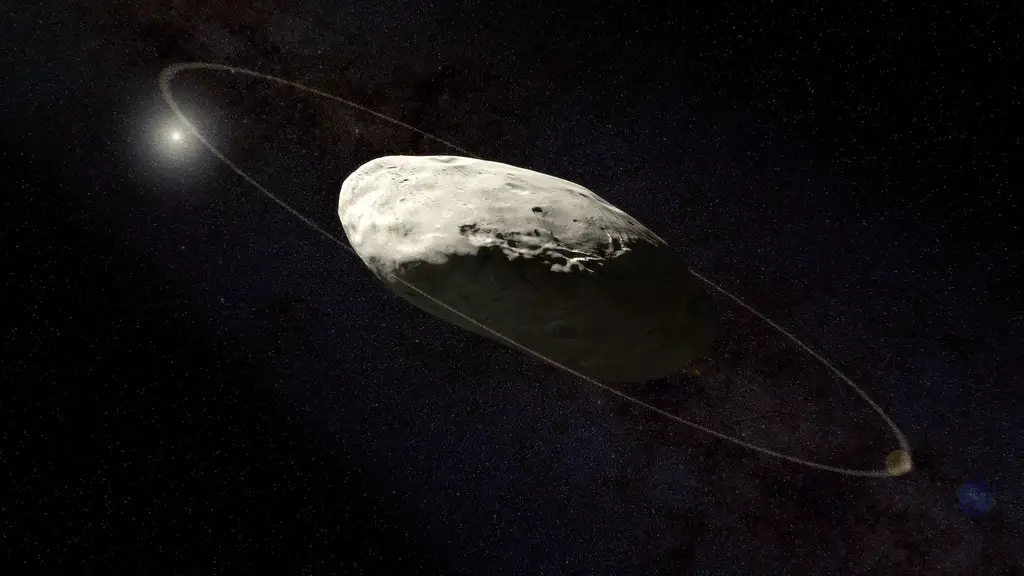Haumea is one of the most interesting bodies in our solar system due to its uniqueness amongst known dwarf planets. The unique characteristics of Haumea includes its elongation, an unusually rapid rotation, its ring, two known moons, high density, and high albedo. In contrast to other dwarf planets, its size, shape, albedo and density are not well constrained.
Haumea is our fifth dwarf planet which was discovered in 2004. It was named after the Hawaiian goddess of birth and fertility. Its two moons, Hi‘iaka and Namaka, were named after goddess Haumea’s daughters. Before the discovery of a celestial body is officially announced, research teams often give their finds temporary code names. Since Haumea was discovered in the days following Christmas, scientists informally codenamed the rocky bodies “Easter bunny” and “Santa,” respectively.
What’s in a Name? For starters, don’t call it Hi-me. Formerly known as 2003 EL61, Hi’iaka is named after one of two mythological Hawaiian sisters from Papa, goddess of Earth. The second sister is Namaka, meaning the waves crash upon her. The moons were discovered by Caltech astronomers as part of their ongoing survey for distant solar system objects. They are thought to be about 150 kilometers (93 miles) across. They are so close to Haumea that they have been influenced by its gravity; they may even be held together by gravity alone, without any sort of collisional history with each other or with Haumea itself. Their orbits around Haumea vary slightly over time, which suggests that they may not be gravitationally bound to each other at all. One of them has a very elongated orbit around Haumea, taking more than three days to complete a single revolution around it.
Dwarf planet Haumea is a member of a group of objects that orbit in a disc-like zone beyond the orbit of Neptune called the Kuiper Belt. This distant realm is populated with thousands of miniature icy worlds which formed early in the history of our solar system about 4.5 billion years ago. These icy, rocky bodies are called Kuiper Belt objects, trans-Neptunian objects, or plutoids.
Haumea is roughly the same size as Pluto. Haumea is one of the fastest rotating large objects in our solar system. It takes 285 Earth years to make one trip around the Sun. As Haumea orbits the Sun, it completes one rotation every 4 hours, making it one of the fastest rotating large objects in our solar system. Its fast spin distorts Haumea’s shape, making this dwarf planet shaped like a rugby ball.
Haumea is the first known Kuiper Belt Object to have rings. Scientists announced the discovery in 2017 after watching the dwarf planet pass in front of a star. Around the main body of Haumea are consistent with the presence of a ring with an opacity of 0.5, width of 70 kilometers and radius of about 2,287 kilometers. The ring is coplanar with both Haumea’s equator and the orbit of its satellite Hi’iaka. The radius of the ring places it close to the 3:1 mean-motion resonance with Haumea’s spin period. That means Haumea rotates three times on its axis in the time that a ring particle completes one revolution.
Haumea is as bright as snow, with a high albedo that is consistent with crystalline ice. Spectral modelling of the surface suggested that 66% to 80% of the Haumea surface appears to be pure crystalline water ice, with the possible presence of hydrogen cyanide or phyllosilicate clays. Inorganic cyanide salts such as copper potassium cyanide may also be present. Haumea’s density is believed to range between 2.6 – 3.3 g/cm³, which is comparable to Earth’s Moon (also 3.3 g/cm³). A large dark red area on Haumea’s bright white surface, possibly an impact feature, has also been observed which could indicate an area rich in minerals and organic (carbon-rich) compounds or possibly a higher proportion of crystalline ice. All of this make Haumea something of an oddity when it comes to dwarf planets.
![]()
